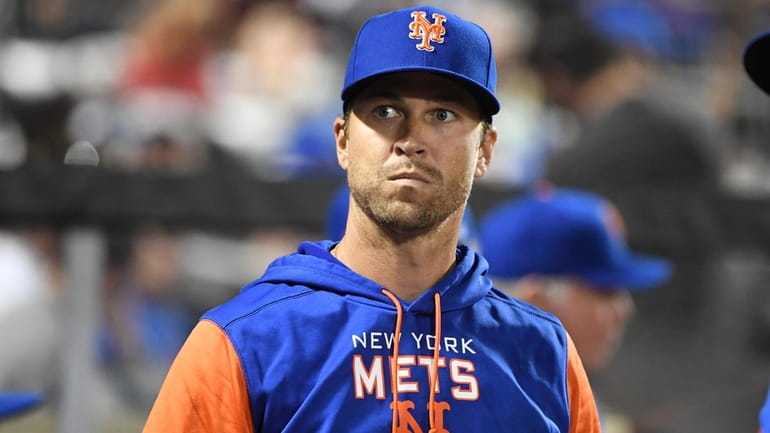Don't rush it, Jake: Mets will benefit from playing it safe with deGrom

Mets pitcher Jacob deGrom looks on from the dugout against the Philadelphia Phillies in an MLB baseball game at Citi Field on Saturday, May 28, 2022. Credit: Kathleen Malone-Van Dyke
It’s hard not to rush it.
Despite the Mets’ cushy lead in the NL East, it’s hard not to cast a wary eye toward the injured list and wonder if they can maintain it with all they don’t have.
Three starters — two of them Cy Young Award winners — a few relievers and a utilityman, all hurt. Their outfield depth, already stretched thin, got even thinner Saturday with the news that Brandon Nimmo might be down for a few days with a sprained wrist.
In the past, that would be enough to trigger a slow panic, and with good reason: This franchise is no stranger to quick starts and quicker swoons, and all too often, those swoons have come courtesy of big-time injuries.
And so, when you get the scene we got Saturday afternoon — Jacob deGrom saying he feels “completely normal,” the pain from the stress reaction in his shoulder blade an old memory — there’s a tendency to look for a quick turnaround.
Why potentially wait until late July when one of the best pitchers on the planet feels this good now? Why keep him throwing on flat ground when a guy like deGrom was basically born to be on a mound?
Well, because the Mets can. And they should.
When Steve Cohen bought this franchise, he also bought the right to exorcise its old demons. He started by showing he was willing to spend money and he kept it going by hiring a proven, capable manager. Now he’s continued the trend by empowering a front office that has managed to construct a team that can withstand the natural rigors and challenges of a long season — injury included.
That last part is key, because the best example of why the Mets suffer when they rush injuries like deGrom’s is . . . well, deGrom himself.
He’s been beset by issue after issue since the 2020 season — neck, hamstring, elbow and shoulder — and there were times when the team’s desperation to get him back fast was palpable.
There’s no definitive way to say that, for instance, the right elbow inflammation that ended his season in July last year was directly tied to the side tightness he felt in May, or the forearm and hand issues he had in June. But we do know that pitching is a delicate, full-body endeavor, and when one part of that body goes haywire, other parts are inclined to overcompensate.
Rushing back anyone, especially someone as valuable as deGrom, indicates a lack of confidence in what you have left, and nothing about this season has warranted that level of panic. What’s more, navigating choppy waters now will help prepare them for whatever happens down the stretch: The path to a championship is never smooth, and those who don’t plan for it are planning for failure.
Which is why Buck Showalter said that when he spoke to general manager Billy Eppler before the season, they mapped out the when, not if, of dealing with significant injuries.
That was on display plenty this past week: Travis Jankowski broke his hand, and though Showalter said they will miss his skill set, they were prepared with other options (they called up Nick Plummer).
With Nimmo out Saturday, Jeff McNeil slotted easily into left; Showalter said he’s even open to using Eduardo Escobar, with 45 games in the outfield over 12 seasons, as an option in a pinch. Mark Canha can play first base, too, he added, unprompted.
“Harmony isn’t the absence of problems but the ability to deal with them, so we’re going to deal with them from within,” Showalter said Friday. “Yeah, on paper, we understand what it looks like. But it’s not like they’re not going to come back. I talked to Max [Scherzer] yesterday. It’s not if, it’s when. So it’s up to us. You know what happens then — when you get there, usually something else happens. You’re getting this back and something else goes away . . . It’s going to happen, so you better be ready.”
DeGrom, for all his desire to get back on the mound, seems to agree. Watching the team be this competitive has him excited, but the thought of pitching pivotal games in September is even better.
“When you’re trying to decide whether to come back too early or not, you kind of look at the long term,” he said. “The team has been playing really good and you want to be there through the end of the year. Trying to walk that fine line of being safe and not trying to do it too quick.”
By all means, walk that line. And feel free to do it slowly.

